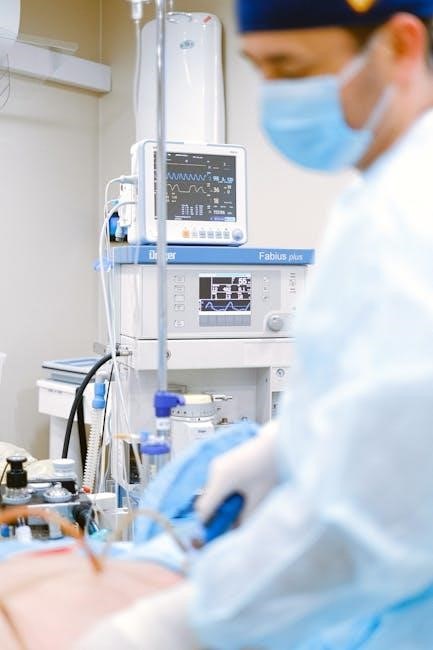Perioperative care in cardiac surgery encompasses preoperative, intraoperative, and postoperative phases, ensuring comprehensive patient management. It integrates anesthesia, surgery, and critical care to optimize outcomes in cardiac procedures.
A multidisciplinary approach enhances patient safety and recovery, making it a cornerstone of modern cardiac surgical practice.
1.1. Definition and Scope of Perioperative Care
Perioperative care refers to the comprehensive medical management of patients before, during, and after surgery. It encompasses preoperative evaluation, intraoperative anesthesia, and postoperative recovery, ensuring a seamless continuum of care. The scope includes patient assessment, risk stratification, and optimization of physiological conditions to minimize complications. It integrates surgical, anesthesiological, and critical care expertise, addressing both cardiac-specific and general surgical needs; This multidisciplinary approach aims to enhance patient safety, reduce morbidity, and improve long-term outcomes in cardiac surgery.
1.2. Importance of Perioperative Management in Cardiac Surgery
Perioperative management is critical in cardiac surgery to ensure patient safety and optimize outcomes. It addresses the unique physiological challenges of cardiac procedures, reducing complications and enhancing recovery. Effective perioperative care improves survival rates and quality of life by minimizing risks such as bleeding, infection, and cardiac instability. It integrates evidence-based strategies, advanced technologies, and multidisciplinary collaboration, making it essential for achieving successful surgical outcomes in high-risk cardiac patients.

Preoperative Care in Cardiac Surgery
Preoperative care in cardiac surgery involves thorough patient evaluation, risk assessment, and optimization to ensure the patient is surgically ready, reducing perioperative risks and complications.
2.1. Patient Evaluation and Risk Assessment
Patient evaluation and risk assessment are critical in perioperative care, involving a comprehensive review of medical history, physical condition, and diagnostic test results. This step identifies high-risk patients and potential complications, guiding personalized care plans. Clinical predictors, such as cardiac function and comorbidities, are analyzed to stratify risk. Advanced tools, including artificial intelligence, enhance decision-making by predicting outcomes like reintubation. Accurate assessment ensures tailored interventions, improving safety and optimizing surgical results. This process lays the foundation for effective preoperative preparation and minimizes perioperative risks.
2.2. Preoperative Preparation and Optimization
Preoperative preparation and optimization focus on enhancing the patient’s physical and metabolic condition to improve surgical outcomes. This phase involves medical evaluations, lifestyle modifications, and patient education. ERAS protocols play a key role, emphasizing evidence-based practices to reduce complications. Interventions may include nutritional support, smoking cessation, and stress reduction. Cardiac optimization strategies, such as managing blood pressure and diabetes, are prioritized. Patient education on postoperative expectations and recovery techniques is essential. By addressing modifiable risk factors, preoperative optimization aims to minimize perioperative risks and accelerate recovery, ensuring the patient is in the best possible state for surgery.
2.3. Diagnostic Techniques and Tests
Diagnostic techniques and tests are critical in perioperative care to assess cardiac function and guide surgical decisions. Echocardiography, cardiac catheterization, and biomarker analysis are commonly used to evaluate myocardial viability and vascular status. These tools help identify potential risks and optimize patient selection for surgery. Advanced imaging, such as MRI or CT angiography, provides detailed vascular anatomy. Electrocardiograms and stress tests further assess ischemic burden. Blood tests, including troponin and BNP levels, aid in risk stratification. By integrating these diagnostic modalities, surgeons and anesthesiologists can tailor strategies to minimize complications and improve surgical outcomes. This comprehensive approach ensures personalized care for each patient.

Anesthesia in Cardiac Surgery
Anesthesia in cardiac surgery ensures patient stability and safety during complex procedures. It involves precise management of hemodynamics, oxygenation, and pain control, tailored to the surgical requirements.
3.1. Types of Anesthesia Used in Cardiac Surgery
In cardiac surgery, general anesthesia is most commonly used to ensure unconsciousness and immobility during procedures. Regional anesthesia, such as epidural or spinal, may also be employed to manage pain.
Local anesthesia is sometimes utilized for minor procedures or as an adjunct to general anesthesia. The choice of anesthesia type depends on the patient’s risk factors and the complexity of the surgery.
Anesthesiologists tailor anesthesia strategies to optimize hemodynamic stability, respiratory function, and postoperative recovery, ensuring patient safety and procedural success.
3.2. Anesthesia Management During Cardiopulmonary Bypass
During cardiopulmonary bypass (CPB), anesthesia management focuses on maintaining hemodynamic stability and optimal organ perfusion. Anesthesiologists carefully monitor the patient’s vital signs and adjust anesthetic depth to prevent awareness or excessive stress response.
Vasoactive drugs are often used to manage blood pressure fluctuations, ensuring adequate cerebral and coronary perfusion. Oxygenation and carbon dioxide levels are closely monitored to prevent organ dysfunction.
The anesthetic plan is tailored to facilitate smooth transition on and off CPB, minimizing ischemic risk and ensuring rapid recovery post-bypass.

Cardiopulmonary Bypass (CPB) Management
Cardiopulmonary bypass management involves precise control of perfusion, temperature regulation, and monitoring of blood flow to ensure optimal organ function and minimize complications during cardiac surgery.
4.1. Initiation and Maintenance of CPB
The initiation of cardiopulmonary bypass involves cannulation of the aorta and venous systems, followed by gradual takeover of circulatory support. Maintaining stable perfusion pressure, flow rates, and oxygenation is critical. Temperature regulation and anticoagulation with heparin are essential to prevent complications. Continuous monitoring of arterial and venous blood gases ensures optimal organ perfusion. The perfusionist and anesthesiologist collaborate to adjust settings, maintaining a balance between adequate blood flow and minimizing-inflammatory responses. Proper management during CPB is vital for patient outcomes, requiring precise coordination and real-time adjustments based on hemodynamic and metabolic parameters.
4.2. Monitoring and Troubleshooting During CPB
Continuous monitoring during cardiopulmonary bypass focuses on maintaining optimal perfusion pressures, oxygenation, and acid-base balance. Venous and arterial blood gases are regularly assessed to ensure adequate tissue oxygen delivery. Potential complications, such as air embolism or electrolyte imbalances, are promptly identified and corrected. Troubleshooting involves adjusting pump flow rates, temperature, and oxygenator function. The perfusionist and surgical team collaborate to address issues like low blood flow or high line pressures. Effective communication and real-time adjustments are critical to minimizing risks and ensuring patient stability during CPB.

Postoperative Care in Cardiac Surgery
Postoperative care focuses on stabilizing the patient in the ICU, monitoring for complications, and managing pain and respiratory function to enhance recovery and reduce morbidity.
5.1. Immediate Postoperative Care in the ICU
Immediate postoperative care in the ICU focuses on stabilizing the patient post-cardiac surgery, ensuring hemodynamic stability, and managing life-sustaining interventions. Monitoring of vital signs, including blood pressure, oxygen saturation, and cardiac output, is critical. Ventilation support and pain management are prioritized to prevent complications. The ICU team also assesses for signs of bleeding, cardiac tamponade, or acute kidney injury. Early mobilization and respiratory therapy are initiated to enhance recovery. Continuous monitoring and prompt intervention are essential to address any postoperative issues, ensuring optimal patient outcomes and reducing the risk of complications.
- Hemodynamic monitoring and support
- Ventilation and respiratory care
- Pain management strategies
- Monitoring for complications
- Early mobilization efforts
5.2. Pain Management and Respiratory Care

Pain management is crucial in the postoperative period to reduce stress, promote comfort, and enhance recovery. Multimodal analgesia, including opioid and non-opioid strategies, is commonly employed. Respiratory care focuses on optimizing lung function, with mechanical ventilation weaning and early extubation prioritized. Techniques like lung expansion exercises and incentive spirometry are used to prevent atelectasis. Adequate oxygenation and monitoring of respiratory mechanics are essential. Early mobilization further supports respiratory recovery, reducing complications and improving patient outcomes.
- Multimodal analgesia strategies
- Respiratory therapy interventions
- Early mobilization practices
- Oxygenation and ventilation management

Myocardial Protection Strategies
Myocardial protection strategies aim to reduce cardiac stress and damage during surgery. Techniques like cardioplegia and hypothermia help preserve cardiac function, minimizing ischemic injury and enhancing recovery.
- Cardioplegia administration
- Hypothermia application
- Ischemic preconditioning
6.1. Pharmacological Strategies for Myocardial Protection
Pharmacological strategies play a crucial role in safeguarding the myocardium during cardiac surgery. Cardioplegia solutions, such as del Nido or St. Thomas’ Hospital solutions, are commonly used to induce cardiac arrest, reducing metabolic demand and preventing ischemic injury. Additional agents like beta-blockers and volatile anesthetics further decrease myocardial oxygen demand. Antioxidants, such as ascorbic acid and N-acetylcysteine, are employed to mitigate oxidative stress. These pharmacological interventions collectively aim to minimize cardiac damage, enhance recovery, and improve patient outcomes.
6.2. Surgical Techniques for Myocardial Protection
Surgical techniques for myocardial protection focus on minimizing ischemic injury and optimizing cardiac function. Cardioplegia administration, hypothermia, and precise surgical techniques reduce metabolic demand. Surgeons employ strategies like minimizing cross-clamp time and ensuring optimal visualization. Novel methods, such as off-pump coronary artery bypass grafting, reduce mechanical stress. Additionally, surgical techniques aim to preserve coronary flow and prevent embolism. These approaches, combined with meticulous intraoperative care, enhance myocardial viability and improve postoperative recovery.

Enhanced Recovery After Surgery (ERAS) Protocols
ERAS protocols integrate evidence-based practices to optimize recovery, reduce complications, and shorten hospital stays. These multimodal strategies improve patient outcomes through standardized perioperative care pathways.
7.1; ERAS Protocols in Perioperative Care
ERAS protocols are evidence-based, multimodal care pathways designed to optimize patient recovery and reduce complications. These standardized strategies integrate preoperative, intraoperative, and postoperative interventions.
Key components include fluid management, pain control, early mobilization, and nutritional support. ERAS principles aim to minimize surgical stress and accelerate recovery, improving overall patient outcomes.
7.2. Impact of ERAS on Clinical Outcomes
Implementation of ERAS protocols in cardiac surgery has demonstrated significant improvements in clinical outcomes. Studies show reduced postoperative complications, shorter hospital stays, and faster recovery times.
Systematic reviews highlight that ERAS components, such as standardized pain management and early mobilization, contribute to enhanced patient recovery and reduced morbidity. These evidence-based practices are increasingly adopted to improve surgical outcomes and patient satisfaction.

Emerging Trends in Perioperative Care
Emerging trends in perioperative care include AI, machine learning, telemedicine, and wearable devices. These innovations enhance surgical efficiency, patient safety, and recovery outcomes.
They also facilitate data-driven decision-making and personalized strategies.
8.1. Role of Artificial Intelligence in Cardiac Surgery
Artificial intelligence (AI) is revolutionizing cardiac surgery by enhancing decision-making, improving surgical accuracy, and optimizing patient outcomes. AI algorithms analyze vast datasets to predict risks, guide interventions, and personalize treatment plans.
Machine learning models enable real-time monitoring during procedures, reducing complications. AI also assists in preoperative planning by simulating surgical scenarios, improving precision in complex cases. Additionally, AI-driven tools enhance postoperative care by predicting recovery patterns and managing potential complications proactively.
Overall, AI integrates seamlessly with perioperative care, offering advanced insights and streamlining workflows to improve surgical success rates and patient safety.
8.2. Minimally Invasive Surgical Techniques
Minimally invasive surgical techniques in cardiac surgery reduce tissue trauma and recovery time, offering benefits like less postoperative pain and shorter hospital stays. These approaches, such as video-assisted and robotic-assisted surgeries, enable precise procedures through smaller incisions, minimizing complications. They are particularly advantageous for high-risk patients, improving surgical outcomes and quality of life. Advanced imaging and robotic systems enhance surgical precision, making these techniques increasingly popular in modern cardiac surgery. Proper patient selection and preoperative planning are critical for successful minimally invasive procedures, ensuring optimal results and faster return to normal activities.